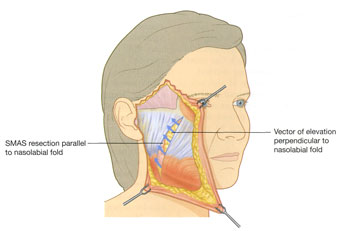
PATIENT RESOURCE
Full information of what you should do
before and after the procedure

There are several different types of facelifts you can choose from based on your aesthetic goals and preferences regarding downtime and recovery, the risks involved as well as your facial anatomy. As a general rule, the different types of facelifts vary by the type of incision, number of tissue layers treated, the area of the face that is targeted, and their degree of invasiveness.

Some of the more popular facelift types are:
The Deep Plane Lift:
 The deep plane lift is considered the gold standard. It involves lifting, releasing and repositioning the superficial musculoaponeurotic system (SMAS). In short, the SMAS layer is located underneath the skin and surrounds the muscles of facial expression; that is, the muscles used for smiling, frowning, and other facial expressions.
The deep plane lift is considered the gold standard. It involves lifting, releasing and repositioning the superficial musculoaponeurotic system (SMAS). In short, the SMAS layer is located underneath the skin and surrounds the muscles of facial expression; that is, the muscles used for smiling, frowning, and other facial expressions.
This more technical procedure involves inconspicuous incisions along the hairline so that the facial muscles and upper fatty tissue layers can be easily lifted and re positioned.
During the deep plane lift, the facial plastic surgeon separates the skin from the SMAS layer, and then enters the “deep plane” by going underneath the SMAS layer to release attachments. It is the release of these attachments that allows the surgeon to re position the SMAS layer, and accompanying skin, in a more youthful, natural, and tension-free position. After the SMAS is re-positioned, excess and loose skin is removed, and the edges are sutured or stapled in place.
The deep plane lift is the go-to lift for people with severe facial sagging and laxity, and for those looking for a longer-lasting lift.
The SMAS Lift:
 The SMAS lift affects the superficial top layers of skin and the deeper tissues of the face and neck. These tissues tend to grow lax and sag with use and advancing age.
The SMAS lift affects the superficial top layers of skin and the deeper tissues of the face and neck. These tissues tend to grow lax and sag with use and advancing age.
To perform a SMAS lift, your facial plastic surgeon creates an incision at the temple, above your hairline. From there the incision is extended downward, following your skin’s natural crease in front of or at the edge of the ear, below the ear lobe and behind your ear. The SMAS is then tightened using sutures, any excess or redundant skin is removed and the remaining skin is stitched up.
The SMAS lift works well for individuals with mild laxity, some jowls and mid-face sagging.The SMAS lift differs from a deep plane lift in that no attachments underneath the SMAS are released.
Short Scar Lifts:
The short scar facelift is an umbrella term for several face lifts that involve abbreviated scars. One such lift involves an S-shaped incision at the temple or in front of the ear. Unlike with other types of face lifts, the short scar lift incision does not extend behind the ear. Your surgeon can still re-suspend the tissues that support your smile lines and jowls and tighten a moderate amount of your loose skin.
Another example of a short scar lift is the minimal access cranial suspension lift (MACS). With this technique, your incision stops right at your ear lobe.